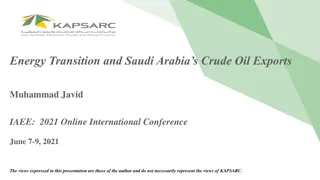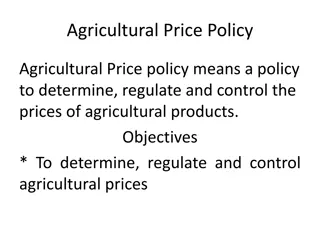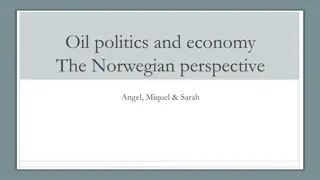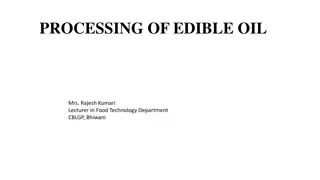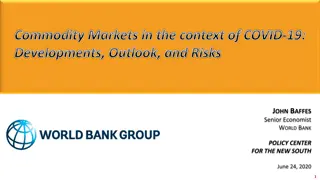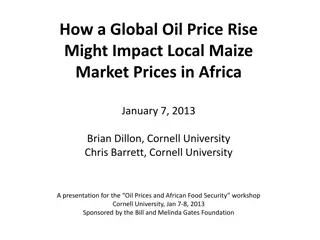Global Energy Dynamics: Oil Prices, Geo-politics, and Economic Shifts
Explore the interplay between oil prices, geo-politics, and the global economy in a new paradigm. Key themes include the dominance of fossil fuels, challenges in transitioning to renewables, and the impact of geopolitical events on energy markets. Dive into discussions on the Ukraine war's effects, global oil production, and the Middle East's significance in shaping oil prices.
Download Presentation

Please find below an Image/Link to download the presentation.
The content on the website is provided AS IS for your information and personal use only. It may not be sold, licensed, or shared on other websites without obtaining consent from the author.If you encounter any issues during the download, it is possible that the publisher has removed the file from their server.
You are allowed to download the files provided on this website for personal or commercial use, subject to the condition that they are used lawfully. All files are the property of their respective owners.
The content on the website is provided AS IS for your information and personal use only. It may not be sold, licensed, or shared on other websites without obtaining consent from the author.
E N D
Presentation Transcript
Oil Prices, Geo-politics, and the Global Economy A New Paradigm? John W. Rogers PH. D. American International College Laufer Energy Symposium March 2023
Key Themes in Global Energy Markets Fossil Fuels continue to dominate energy consumption Despite broad agreement on dangers from climate change and its link to fossil fuels Not much agreement on how to move forward: Paris Climate Accords, US position, EU position, China and Emerging Markets How realistic is the move to renewables? Unintended Consequences: Impact of oil pricing on currency markets Geo-political realignments
2021 - Where do we go after 20 years of Volatility ?
Ukraine War Black Swan The war has upended energy markets Despite sanctions Russian oil is still flowing into world markets Asian customers have replaced Europeans, but they demand lower prices European price cap and warm winter have weaned region from Russian energy Has this accelerated the move to renewables?
Geo-politics and Economics The Middle East remains the swing region OPEC + can continue to dictate prices of a fungible global commodity Russia is more important than was generally realized Outside of the US, oil production is largely in the hands of state owned/controlled enterprises (SOEs) Oil prices are subject to geo-political events and drive geo-political outcomes
Is This Time Different ? Ben Bernanke (former Chair of US Federal Reserve) and Peter Obstfeld (IMF) charted correlations between oil prices and the stock market Hypothesis: falling oil prices lead to higher stock prices and vice versa Null Hypothesis: this inverse relationship is not statistically significant Determining factor is overall growth of the economy Post-Ukraine rise in oil prices and stock market correction seems to validate the hypothesis
A Tale of Two Cities The End of the Oil Age Climate Change is the great disruptor Paris Accords endorsed by President Biden De-carbonize the economy to keep temperature change < 2 degrees Celsius Supply and Demand Realities Inflation and Commodity Boom Supply Constraints Prices of Brent Crude up from $20 to $80 per barrel
Climate Change: Paris Goals Net emissions have grown 40% in thirty years Paris commitment: 90% reduction over next 30 years Global population increases by 2 billion; gross product triples 2019 before pandemic 55 gigatons of greenhouse gas emitted One-fifth from agriculture; four-fifths from burning fossil fuels
Global Trends BP Annual Report Fossil fuels still contribute 84% of global consumption Energy consumption has increased annually since the Recession of 2008 2009 Share of coal fell by largest amount since 1965 Renewables growth wind is highest followed by solar Nuclear on fastest growth since 2004 with Japan and China largest contributors Since Kyoto Protocol 1997 carbon emissions have risen 50%
What is to be done? IEA estimates $1.2 trillion investment needed in new power grids ESG investing mandates moving capital out of fossil fuels Climate related investments grew 70% in five years before pandemic Carbon taxes cover 1/5 of economy; should cover all by 2030 Carbon tax rises from average $20 per ton to $100 per ton
The Majors European oil giants BP, Royal Dutch Shell, Total have espoused lower carbon strategies ExxonMobil the largest oil company has been a hold out, but In May 2021 the hedge fund Engine 1 forced two low carbon advocates onto the Board California and New York pension funds major asset managers of Exxon stock backed the move Investors now view climate risk as a core component of long-term value
Political Realties: Petro-states Financial pressure on budgets of oil producers: Algeria needs price of $100 + per barrel Russia needs $64 per barrel Only Qatar balances at price below $50 Saudi Arabia Vision 2030 becomes Vision 2020 Oil revenues in Middle East and North Africa fell from $1 trillion in 2012 to $575 billion in 2019
Political Realities China Chinese firms produce 72% of the world s solar modules 69% of its lithium-ion batteries 45% of its wind turbines. They also control much of the refining of minerals critical to clean energy, such as cobalt and lithium Will China become an electro-state
An Alternative: Natural Gas Oil majors see natural gas as bridge fuel Gas output will rise to 50% of hydro-carbons by 2025 LNG capabilities can supply world-wide demand But John Kerry says that natural gas risks being stranded as prices of wind and solar alternatives fall
An Alternative ? Safe and Clean Nuclear Power Nuclear power supplies 20% of US energy and is carbon free Carbon taxes might make nuclear more economically viable New technology makes nuclear cheaper and safer
Are These Really the Alternatives? Problems of Recycling and Land Usage Damage to Eco-Systems
Hydroelectric Power Excellent Backup Source No Carbon Emissions Sustainable Flood Control, Irrigation, Recreation But Damage to Environment Loss of Land to Existing Owners and Indigenous People
Supply and Demand Realities In April 2020 Brent was priced at $20; WTI briefly fell to zero In April 2021 Brent and WTI touch $70; Goldman Sachs thinks price could hit $80 War in Ukraine pushed prices higher, but they have retreated to level prior Saudi Arabia and Russia in agreement on continued supply restrictions Concern about attacks on Ras Tanura refinery and export complex Biden administration to spend $1.9 trillion on infrastructure China imports rising and supply constrained
Global Commodities Boom Gold hit $2000 per ounce for first time Corona virus slow down in Brazil and La Nina drought in Latin America Goldman Sachs: the pandemic is beginning of commodities super-cycle Green investment is energy intensive and may boost oil demand Weaker dollar and inflation fears
Fanning the Flames: MMT Government deficits to fight Covid-19 prompt fiscal policy stimulus Central banks prefer inflation to deflation Modern Monetary Theory: deficits do not matter Federal Reserve will keep interest rates low into 2023 US money supply increased 40% in 2020
The Battle of Two Theories Milton Friedman Inflation is always a monetary phenomenon Alexandra Ocasio Cortez Politics can manage inflation
Lessons from post-pandemic Booms Pent up demand and high savings rates The Roaring Twenties followed the Spanish flu More risk taking and entrepreneurship Political tensions and concern about inequality Reconfigure supply chains with pressure on globalization Ukraine war and US-China tensions add new element into the mix
Scenario Analysis Long term trends toward green energy put cap on oil prices and eventually downward pressure But Inflationary pressures and recovering global demand along with constrained supply work in the opposite direction And War in Ukraine remains a wild card
Dollar Dominance in Jeapordy Weaponizing monetary policy European Union President Jean-Claude Junker: selfish unilateralism Mohammed El-Erian: You cannot replace something with nothing Chinese yuan, Digital Currency, market basket Death by a thousand cuts
Currency Wars - War in Ukraine and embargo on Russian oil may have accelerated move away from $US - India and China use Chinese yuan for oil purchases; Saudi Arabia may follow - Role of $US as reserve currency
Political and Geopolitical Bad Habits Unilateral opposition to China Group Think Relentless government spending and deficits of last two decades National debt has risen from $6.5 to $31 trillion in 20 years Federal Reserve balance sheet has grown from $730 billion to $8.7 trillion Since 2010 dollar reserves have declined from 70% to 60% Only financial crisis in which dollar has not appreciated as safe haven Continued spending relies on status of dollar as reserve currency
Conclusion There are no easy answers Managers need to understand the drivers of oil pricing and monitor its impact Some of the old models apply; others e.g. legacy automobile companies - risk being stranded by disruption Joseph Schumpeter: Capitalism is a process of Creative Destruction






